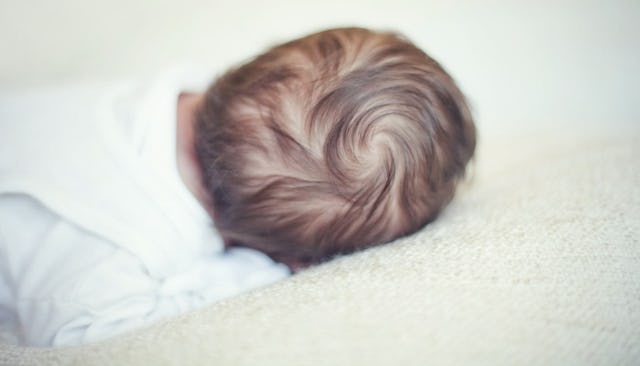The Guilt And Worry Of New Motherhood

My venture into head-hunting began this past winter. My subconscious brain took over and I was studying the backs of strangers’ heads for the degree of roundness; something I never contemplated, nor cared to notice, before. I pinpointed the roundest of them all and watched to see how that facet of one’s external appearance transformed their overall persona. Did a rounder head make for a more likable face? Would they get that job over someone else?
When I gave birth to my son, I foolishly assumed my worrying for his survival was over. There he was — pink, screaming, and breathing. I hadn’t realized that his survival wasn’t just his being alive, but how he feels, his future opportunities, and his ability to thrive in a world I trust less since I toddled around. School shootings, cyberbullying, and drugs are all far more widespread than in the ’80s and ’90s in which I grew up. And back then, you didn’t see many infants in helmets designed to reshape their skulls. There is one thing, though, that has declined since the 1990s; sudden infant death syndrome (SIDS) has dropped by 50%.
In 1992, the Safe to Sleep Campaign began recommending that newborns and infants always be placed on their backs to sleep, in a crib with tight-fitting sheets, and no blankets, bumpers, or toys. This movement, which has lessened the number of crib deaths, has also raised the amount of children with flat-looking skulls. The helmet you see some babies wearing is thought to combat plagiocephaly — the flattening of the head — and is worn 23 hours a day, only removed for bath time. As the child’s head grows, the inside of the helmet is shaved down to encourage the flat side to round out.
My son was just 8 weeks new when I brought him to a free tummy-time class. I was excited to show off my little man who lifted his head off of my chest at birth. The woman, a specialist in childhood physical therapy, watched the four babies, my son being the youngest, with the eye of a detective scrutinizing their movements and reaction to play. Her grimacing looks in our direction made my stomach ache with worry — mother’s worry — a full-bodied, intuitive dread that something was wrong.
“Do you see how his head is cocked to the side?” she asked. I thought it was cute, the way he leaned to the right and smiled at me. Now, I racked my brain. Did he always lean this way? As his mother, I would’ve noticed, right? Everything I knew as a new mom — which wasn’t much to begin with — slowly unraveled as she placed a toy in front of my son and moved it from his left to his right. She circled him, staring from every angle and grimaced again. I wanted to grab my baby and leave, but panic pinned me to the mat.
“Do you notice this flat spot on his right side? See how it’s pushing his facial features?” She pointed to his right eye. “This ear is positioned slightly more forward and this eye is more closed.” I nodded, but I didn’t really see it, and for that, I felt like a complete and utter shit parent.
Tears fell onto the blanket my son lay on. I was embarrassed by my inability to see a mild facial deformity in the newborn I mothered for the past 56 days. It felt like it was my fault. I should’ve known tummy time was more than a suggestion. I felt guilty for laying him in the swing. I was sure I had failed him and he would never fill out a baseball cap.
I drove to the pediatrician where it was confirmed that our baby was one of the 13% in the country with plagiocephaly and it was caused by torticollis — a tight neck — which often happens in utero when large babies like my own have little room to move. One side of the neck becomes tight, and the baby who is placed on his back to sleep then leans on one side of the head and a flat spot is molded. The treatment was physical therapy sessions twice a week.
My obsession with head-gazing began. Over dinner one night, my husband and I both admitted to staring at the shape of strangers’ skulls. No one told me before I had a child that worry often takes the least expected direction; it’s almost never rational and keeping it at bay can be an all-consuming task.
At physical therapy, my son’s neck strengthened quickly. Once he started rolling over at 3 months old, he preferred to spend most of his days on his belly, even for sleeping. His eyes are now the same size, and you’d never be able to tell his ear had ever been anywhere but in line to the other. His flat spot rounds out a little more each day.
As the eldest of five children, I didn’t expect motherhood to be easy, but I also hadn’t understood how emotionally drained my mother must’ve been each night. My son will never remember that part of his head was once flat and now I know his head shape is a silly thing to worry about. He wants for little more than food, play, and love, and he receives them all in abundance. What I know to be true so far is that motherhood is not only about your child’s growth and development, but your own as well.
Last week, a woman leaned in and complimented what a nice, round head my son had. I smiled. She didn’t need to know that we worked on it.
This article was originally published on